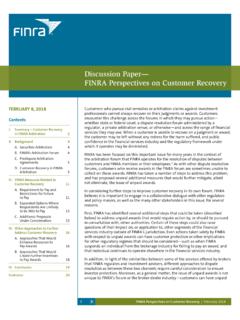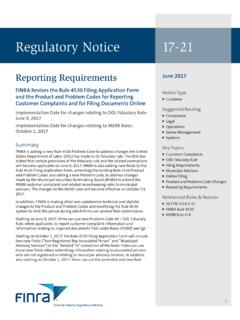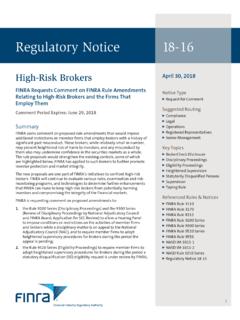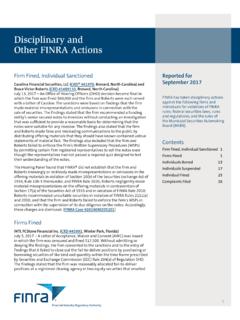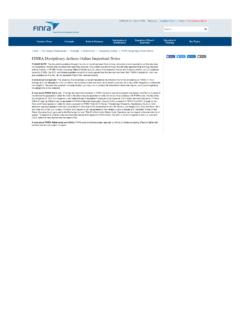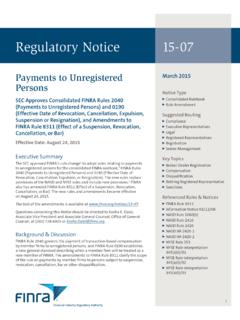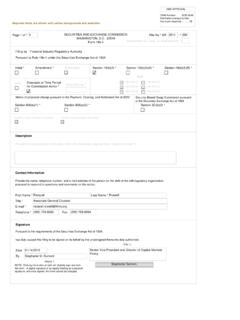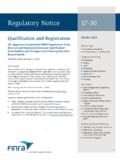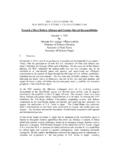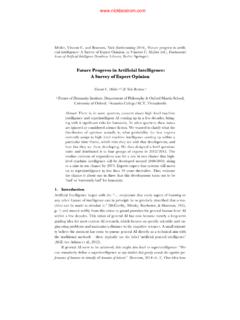Transcription of Report on Conflicts of Interest - October 2013
1 A Report FROM THE FINANCIAL INDUSTRY REGULATORY AUTHORITY Report on Conflicts of InterestREPORT ON Conflicts OF Interest October 2013 October 20131 EXECUTIVE SUMMARYC onflicts of Interest can arise in any relationship where a duty of care or trust exists between two or more parties, and, as a result, are widespread across the financial services industry. While the existence of a conflict does not, per se, imply that harm to one party s interests will occur, the history of finance is replete with examples of situations where financial institutions did not manage Conflicts of Interest fairly. Indeed, many of the foundational pieces of legislation governing financial services in the United States contain provisions crafted precisely to address conflict Report focuses solely on broker-dealers, the entities the Financial Industry Regulatory Authority (FINRA) regulates.
2 Broker-dealers are subject to comprehensive regulation under the federal securities laws, Securities and Exchange Commission (SEC) rules and FINRA Conflicts of Interest are an SEC and FINRA priority and have been addressed through rulemaking, oversight and enforcement (See Appendix I for a non-exhaustive list of Conflicts -related rules.)This Report carries those efforts forward. It recognizes that many broker-dealer firms have made progress in improving their Conflicts management practices, but emphasizes that firms should do more to manage and mitigate Conflicts of Interest in their assist in these efforts, FINRA launched its Conflicts initiative in July 20124 to review firms approaches to Conflicts management and to identify effective We used firms responses to FINRA s Conflicts review letter, in-person meetings and a follow-up compensation questionnaire to develop the observations detailed in this Report .
3 The Report is not intended as an inventory of Conflicts that firms face, nor does it cover many Conflicts that federal securities laws and SEC and FINRA rules already address, such as investment banking-research separation, outside business activities, soft dollars, payment for order flow or securities allocations to customers. Instead, FINRA s objective is to focus on firms approaches to identifying and managing Conflicts in three critical areas firms : 00enterprise-level frameworks to identify and manage Conflicts of Interest ;00approaches to handling Conflicts of Interest in manufacturing and distributing new financial products; and00approaches to compensating their associated persons, particularly those acting as brokers for private Conflicts Governance Framework 5 New Business and New Product Conflicts Review 18 Compensation and Oversight 26 Appendix I Conflicts Regulation in the United States and Selected International Jurisdictions 37 Appendix II Text of FINRA Letter to Firms Announcing Conflicts Review 40 Appendix III Summary of Conflicts Identified by Firms 41 Endnotes 43 Report ON Conflicts OF Interest October 20132 The enterprise-level framework discussion examines how firms address Conflicts across their business lines from a top-down perspective.
4 The new product and new business discussion explores how firms address Conflicts related to the introduction of new products and services. Together, these areas play critical gatekeeper roles. Specifically, if firms are effective with enterprise-level frameworks and handling Conflicts with new products, they can be proactive in identifying and managing Conflicts . The focus on compensation provides insight on financial incentive structures that may create, magnify or mitigate Conflicts of Report identifies effective practices that FINRA observed at firms or that, based on experience and analysis, FINRA believes could help firms improve their Conflicts management practices. It also contains more general observations and commentary on firms practices that we share for the industry s information. FINRA recognizes that the effective practices and observations in this Report are drawn from discussions with large firms and, as a result, will not in all cases be directly applicable to small firms.
5 This Report is a point-in-time review of several facets of Conflicts of Interest . Given Conflicts pervasiveness and potential to cause customer harm, FINRA will continue to assess firms Conflicts management practices and the effectiveness of those practices in protecting customers interests. FINRA will also monitor the effectiveness of approaches to Conflicts regulation used expects firms to consider the practices presented in this Report , and to implement a strong conflict management framework. If firms do not make adequate progress on Conflicts management, FINRA will evaluate whether rulemaking to require reasonable policies to identify, manage and mitigate Conflicts would enhance investor stresses that this Report is not intended to express any legal position, and does not create any new legal requirements or change any existing regulatory obligations. Throughout the Report , we identify Conflicts management practices that we believe firms should consider and tailor to their business model as they strengthen their own Conflicts of Interest FrameworkThe first focus of this Report is firms enterprise-level Conflicts of Interest frameworks.
6 We use the term framework to mean the combination of underlying ethics culture, organizational structures, policies, processes and incentive structures that, in their totality, shape a firm s management of Conflicts of effective practice is for firms to implement an articulated, firm-wide framework to manage Conflicts of Interest , and FINRA observed a number of firms that implemented many facets of such a framework. The key to making such a framework effective begins with the tone from the top. To be effective, firm leadership should require not only adherence to the letter of the law, but a commitment to the highest ethical standards and to putting customers interests first. Of course, reliance on the tone from the top to address Conflicts of Interest is insufficient by itself. As appropriate to the scale and complexity of a firm s business, elements of an effective practice framework for managing Conflicts of Interest include:00defining Conflicts of Interest in a way that is relevant to a firm s business and which helps staff identify conflict situations;00articulating employees roles and responsibilities with respect to identifying and managing Conflicts ;00establishing mechanisms to identify Conflicts in a firm s business as it evolves; Report ON Conflicts OF Interest October 2013300defining escalation procedures for Conflicts of Interest within and across business lines;00avoiding severe Conflicts , even if that avoidance means foregoing an otherwise attractive business opportunity;00disclosing Conflicts of Interest to clients, taking into consideration the different needs of retail and institutional clients.
7 00training staff to identify and manage Conflicts in accordance with firm policies and procedures; and00reporting on significant Conflicts issues, including on a firm s own measures to identify and manage Conflicts , to the Chief Executive Officer (CEO) and Product ConflictsThe second focus of this Report is the introduction of new financial products. Firms at the forefront of financial innovation are in the best position, and are uniquely obligated, to identify the Conflicts of Interest that may exist at a product s inception or that develop over are a number of effective practices firms can adopt to address such Conflicts . First, firms can use a new product review process typically through new product review committees that includes a mandate to identify and mitigate Conflicts that a product may present. Second, firms should disclose those Conflicts in plain English, with the objective of helping ensure that customers comprehend the Conflicts that a firm or registered representative have in recommending a These Conflicts may be particularly acute where complex financial products are sold to less knowledgeable investors, including retail , product manufacturing firms can implement effective Know-Your-Distributor (KYD) policies and procedures.
8 These KYD measures help mitigate the incentive to increase revenue from product sales by using distribution channels that may not have adequate controls to protect customers , firms can perform post-launch reviews of new products to identify potential problems with a product that may not have been readily apparent during the initial review or that may have arisen as a result of economic events and take remedial , firms can carefully evaluate and decline to offer products to customers when the Conflicts associated with those products are too significant to be mitigated reduce Conflicts , firms private wealth businesses should operate with appropriate independence from other business lines within a firm. FINRA is encouraged by firms general adoption of open product architectures ( , the sale of third party in addition to proprietary products). Nonetheless, firms involved in both the manufacture and distribution of products should maintain effective safeguards to alleviate pressure to prefer proprietary products to the detriment of customers interests.
9 This is particularly important as firms seek to leverage their brokerage and other platforms to cross-sell products and services. Equally important, firms with revenue sharing or other partnering arrangements with third parties should exercise the necessary diligence and independent judgment to protect their customers ON Conflicts OF Interest October 20134 Compensation PracticesThe final focus of this Report is compensation. Although the primary focus is on brokerage compensation (and related supervisory and surveillance systems), the Report also addresses the application of tools to mitigate Conflicts of Interest in compensation for associated persons more generally. Many firms have considered and taken steps to mitigate these Conflicts directly through changes to compensation arrangements and through supervision of registered representatives sales use of product agnostic compensation grids (also referred to as neutral grids ) can be an effective practice to reduce incentives for registered representatives to prefer one type of product ( , equities, bonds, mutual funds, variable annuities) over These grids typically pay a flat percentage of the revenue a registered representative generates, regardless of product recommended.
10 FINRA notes, however, that while this eliminates one variable that may influence recommendations, registered representatives still have an incentive to favor products with higher commissions because these produce larger payouts. Consequently, to reduce Conflicts , firms should take measures to mitigate biases that differences in compensation by product may effective practice is for firms to link surveillance of registered representatives recommendations to thresholds in a firm s compensation structure to detect recommendations, or potential churning practices, that may be motivated by a desire to move up in the compensation structure and, thereby, receive a higher payout supervision and surveillance of a registered representative s recommendations as that person approaches other significant compensation or recognition milestones is a related effective practice.
